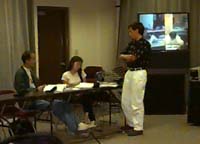CHN 201: Intermediate Mandarin (return to directory page)
| Instructor: | Stephen Fleming | |
| Contact: | Tel: 956-2533; Fax: 956-5983; e-mail: sfleming@hawaii.edu; home page: http://nts.lll.hawaii.edu/sfleming/ | |
| Class Time: | Monday - Friday, 8:00 - 8:50 a.m. | |
| Location: | The origination site will be Webster Hall on the Manoa campus, Room 204. | |
| Office Hours: | By appointment, Room 105, Temporary Architecture Portables (diamondhead/mauka of Korean Studies), Manoa campus. |
 Please note
that this class will be broadcast via HITS (the Hawai'i
Interactive Television System) to several remote
locations. Students may choose to take the course from a
studio classroom at one of the remote transmission sites.
Students at remote sites have full interactivity via
video and voice with the teacher and the students at all
other locations. Possible remote sites include Hawai'i
Community College (Hilo), Kapi'olani Community College,
Kaua'i Community College, Leeward Community College, and
Maui Community College. Contact instructor for further
information. The instructor will make every attempt to
visit each remote site at least once during the term.
Students at remote locations register at Kapi'olani
Community College.
Please note
that this class will be broadcast via HITS (the Hawai'i
Interactive Television System) to several remote
locations. Students may choose to take the course from a
studio classroom at one of the remote transmission sites.
Students at remote sites have full interactivity via
video and voice with the teacher and the students at all
other locations. Possible remote sites include Hawai'i
Community College (Hilo), Kapi'olani Community College,
Kaua'i Community College, Leeward Community College, and
Maui Community College. Contact instructor for further
information. The instructor will make every attempt to
visit each remote site at least once during the term.
Students at remote locations register at Kapi'olani
Community College.
Click here for current homework.
Course Goals & Objectives:
CHN 201 is the first of two semesters of Intermediate Mandarin.The College of Arts and Sciences requires that undergraduate students complete second/foreign language studies through the 202 level in order to graduate. Placement in CHN 201is predicated upon successful (C or above) completion of CHN 102 or placement into the course by the East Asian Languages & Literatures Undergraduate Coordinator, Ted Yao, tel. 956-2071, email tyao@hawaii.edu. (Please remember that if you use the "mail" function in your browser by clicking the above address, the mailer will use whatever return address is set in the browser's preferences. Make sure you include your own email address in the body of your message.
In CHN 201, students will gain listening, speaking, reading and writing skills in standard (Mandarin) Chinese, attaining approximately the Intermediate Mid level on the ACTFL/ETS proficiency scale. Specifically, students will be able to achieve the following.
- Listening Able to understand sentence-length utterances, especially where context supports understanding and speech is clear -- such as in survival situations involving native speakers accustomed to dealing with foreigners. Comprehends limited vocabulary connected with simple survival situations such as finding food, clothing, transportation, health care, and shelter, participating in recreational activities, and making friends.
- Speaking Able to make short statements and ask simple questions, with emerging ability in advanced tasks such as narration, description, and comparison. Language is generated through application of internalized grammar rather than relying solely on memorized material. Vocabulary centers around survival topics: common objects, places, activities, basic likes and dislikes, food, clothing, shelter, etc.
- Reading Can identify a moderate number of character components and high-frequency characters in areas of immediate need. Where specific characters and combinations have been memorized, can read for instructional and directional purposes standardized messages, such as prices in stores, time/date on schedules, simple correspondence, and simple instructions. In terms of literacy, can read textbook materials as covered.
- Writing Able to write simple, short narratives, descriptions and notes on daily topics. Can supply information on simple forms and documents.
Texts
and Materials
Integrated Chinese
(Textbook, Workbook, and Character Workbook, 3 volumes)
Level One, Part Two -- we will begin with Lesson 16 and
progress rapidly! -- and later, the same series' Level
Two will be the primary texts used. Tapes for Integrated
Chinese will be available at the Language Labs at
Manoa for listening AND for copying on an ongoing basis,
beginning in the third week, and for students at remote
sites we will have to figure out a solution for getting
tapes duplicated on site or by mail. (This may mean
providing even more blank tapes.)
Although our text is in traditional characters, we will
be working with both simplified and traditional character
texts in class. (The general principle for simplified and
traditional characters is: be able to read both types,
and write at least one.)
Additionally, I will be asking everyone to purchase a
dictionary.
Teaching/Learning
Format
Everyone has a different style of learning. Some people like to stick to a book; some people like free conversation. Some people feel more in control if they know how the grammar works; others are terrified of grammar. Some say they can only learn to read characters by learning how to write them first; some say they have to know how to read them before they can write them-and so forth. I will be attempting to mix different activities so that there is something for everyone. If you don't like a particular activity, try to remember that there are others who may get more out of it. If you are really unhappy about the way things are being done, please email me so I can help you out. Electronic mail is an essential part of the course, and is the medium of choice for getting help on grammar and other language-form problems (tones, etc.). You may e-mail classmates individually (see class list) or all at once. Reasons to use e-mail include:
- You need a question about language answered. Try e-mailing the teacher, the list, or an individual classmate.
- You wish to announce a class event (such as a study party). We love em!
Student responsibilities
Only a portion of time in class will be spent on the textbooks; we will not cover them exhaustively in class, but you are expected to do so independently, especially through use of the tapes. Previewing the lesson, with use of the tapes, can really improve your performance in class and in the course. Please come to class every day, prepared and ready to communicate in both speech and writing.
Grading
| Daily score | A global rating on a 100-point scale, assigned according to participation, completion of preparatory work, and performance. | 20 | ||
| Tests | Tests are at least once a week (excluding midterm and final). | 50 | ||
| Midterm and Final | The final will receive somewhat greater weight than the midterm, but the two together will comprise about a third of the grade. | 30 |